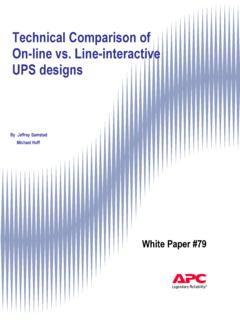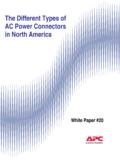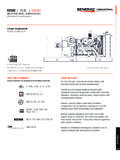Transcription of Fundamental Principles of Generators for …
1 Fundamental Principles of Generators for Information Technology White Paper #93 By Robert Wolfgang 2004 American Power Conversion. All rights reserved. No part of this publication may be used, reproduced, photocopied, transmitted, or stored in any retrieval system of any nature, without the written permission of the copyright owner. Rev 2004-0 2 Executive Summary Every Information Technology professional who is responsible for the operation of computing equipment needs to ensure their data center or network room is prepared for extended utility power outages. Understanding the basic functions and concepts of standby generator systems helps provide a solid foundation allowing IT professionals to successfully specify, install, and operate critical facilities.
2 This paper is an introduction to standby Generators and subsystems that power a facility s critical electrical loads when the utility cannot. 2004 American Power Conversion. All rights reserved. No part of this publication may be used, reproduced, photocopied, transmitted, or stored in any retrieval system of any nature, without the written permission of the copyright owner. Rev 2004-0 3 Introduction A standby generator system is composed of two basic subsystems: (1) the generator, which is made up of the prime mover, the alternator, and the governor, and (2) the distribution system, which is made up of the Automatic Transfer Switch (ATS) and associated switchgear and distribution. Figure 1 illustrates a typical standby generator. This paper explains these major subsystems and their basic function, however, it is an introductory paper from a suite of related APC papers on more advanced generator system topics, and provides references for readers interested in a more complete treatment of the subject.
3 Figure 1 Standby generator When investing in a generator system one should be aware of the technological advantages afforded by today s systems, and the significant advances in reliability and functionality that have been made over the past 10-15 years. Older generator systems can often be retrofit to meet current requirements. See APC White Paper #90, Essential Generator System Requirements for Next Generation Data Centers for a further discussion on essential generator system requirements for today s mission critical facilities. 2004 American Power Conversion. All rights reserved. No part of this publication may be used, reproduced, photocopied, transmitted, or stored in any retrieval system of any nature, without the written permission of the copyright owner. Rev 2004-0 4 The Prime Mover: Internal Combustion Engine What is internal combustion?
4 Chances are, an internal combustion engine powers the car you drive today. The internal combustion engine is the well-respected workhorse of the later half of the 20th century, and has carried this role into the new millennium. In basic terms an internal combustion engine converts its fuel source into mechanical motion via its internal moving parts. As outside air mixes with the fuel inside the engine these moving parts ignite the air / fuel mixture to create a controlled internal explosion (combustion) within cavities known as cylinders. Although there are numerous variations of the internal combustion engine, the most commonly used for standby generator systems is the 4-stroke engine. It is referred to as a 4-stroke because of the four distinct stages that occur in the combustion cycle.
5 These stages include intake of the air / fuel mixture, compression of that mixture, combustion or explosion, and exhaust. When referring to Generators the engine is generally referred as the prime mover. The following describes the core attributes associated with the prime mover. Fuel There are four main fuels used in internal combustion engines. These include diesel, natural gas, Liquid Petroleum (LP), and gasoline. The selection of a fuel type depends on variables such as storage, cost, and accessibility. Exhaust, Emissions & Noise The generator system exhaust is a significant issue when it comes to air and noise pollution. While the concept of attenuating noise and ducting exhaust air is straightforward, the environmental and regulatory issues are not. EGSA (Electrical Generating Systems Association) is a worldwide organization that offers a wealth of information about emissions and other standby generator considerations.
6 Environmental laws, building permits, and duration of generator use vary considerably by locale. For example, the United States Federal Environmental Protection Agency (EPA) has delegated to each state the jurisdictional authority and discretion on how to achieve air quality goals established on the national level. Other countries have similar regulatory bodies that set limits on generator emissions. For instance, Defra (Department for Environment Food and Rural Affairs) sets policies for environmental protection in the United Kingdom. And in India the Ministry of Environment and Forests (MoEF) plays this role. If the facility is located in a stringent area, the generator system declarations on emissions may be required when applying for permits. Industry professionals are usually experienced with the approval process in the locations they serve.
7 Another matter subject to the acceptance of jurisdictional authorities is that of noise pollution. Local ordinances on noise pollution typically put it in context with the highest recordable background noise observable in a 24-hour period. Exhaust mufflers are generally categorized as industrial, residential, or critical. Critical offers the highest level of sound reduction. To spare the expense of a retrofit design, one should consider the noise rating of the system prior to purchase and have these numbers qualified by the zoning authority in the planning stages. Mechanical vibration also contributes to the overall noise level and the perception of noise for occupants in the surrounding area. Mounting and isolation techniques exist to minimize this concern. 2004 American Power Conversion.
8 All rights reserved. No part of this publication may be used, reproduced, photocopied, transmitted, or stored in any retrieval system of any nature, without the written permission of the copyright owner. Rev 2004-0 5 A third matter that is important to discuss is that of aesthetics, since Generators may be subject to the acceptance of local municipalities. Some municipalities have requirements in terms of placement of the generator, including requiring that it be housed within concrete / block walls that match the main building s appearance. This keeps the generator from being noticed and keeps it aesthetically neutral to the surrounding neighborhood. Combustion Air Intake It is important that provisions for cool, clean airflow to the engine be incorporated into the room's design.
9 It is also suggested that ample cool, fresh air be brought in for the comfort of the personnel. Often this requires large vents and possibly supplemental fans. Precautions should also be made to prevent rain, snow, and debris introduction into the system. Cooling The majority of prime movers for generator applications are cooled with a radiator cooling system much like the cooling system in an automobile. A fan is used to move sufficient air over the radiator to maintain moderate engine temperature. The waste heat is drawn off the radiator to the outside, with ductwork of the same cross-sectional area as the radiator face. The intake air opening (louvers into the room) is typically 25-50% larger than this ductwork. Rigorous maintenance of the cooling system is needed for reliable operation.
10 Coolant hoses, coolant level, water pump operation, and antifreeze protection must be diligently reviewed for acceptable performance. Lubrication Modern 4-stroke engines utilize full-flow filter systems, which pump the lube oil through externally mounted filters to prevent harmful particles and contaminants from damaging the moving parts or bearings. Make-up oil reservoirs are used to maintain proper oil level, and external oil coolers assist in preventing lubrication breakdown due to high temperatures. Filters: Air & Fuel Air and fuel are critical elements for the reliable operation of the prime mover. It is essential that a proper maintenance schedule be followed. A system that includes dual redundant fuel lines and filters is a significant benefit in mission-critical applications where long runtime must be supported.








